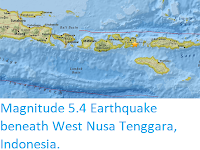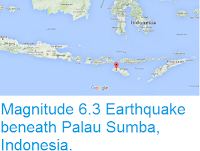Four people have been confirmed dead and another four are missing following a landslide at Kampung Culu in Mbeliling District on Flores Island in East Nusa Tenggara Province, Indonesia, which happened overnight between Thursday 7 and Friday 9 March 2019. Rescue teams are still searching for the missing persons, as well as trying to clear debris from a road which it buried, which serves as the main access route between the westernmost portion of Flores and the rest of the island. The incident happened amid heavy rains that have brought flooding to parts of the island.
The approximate location of the March 2019 Flores landslide. Google Maps.
Flores has a tropical climate, with a Rainy Season related to the Northeast Monsoon that lasts from December to March, with each of those months typically receiving more than 250 mm of rain. Indonesia has two distinct Monsoon Seasons, with a Northeast Monsoon driven
by winds from the South China Sea that lasts from November to February
and a Southwest Monsoon driven by winds from the southern Indian Ocean from March to October (this Southern Monsoon does not typically reach Flores, resulting in a dry season over these months). Such a double Monsoon Season is common
close
to the equator, where the Sun is highest overhead around the equinoxes
and lowest on the horizons around the solstices, making the solstices
the coolest part of the year and the equinoxes the hottest.
The winds that drive the Northeast and Southwest Monsoons in Southeast Asia. Mynewshub.
Monsoons
are tropical sea breezes triggered by heating of the land during the
warmer part of the year (summer). Both the land and sea are warmed by
the Sun, but the land has a lower ability to absorb heat, radiating it
back so that the air above landmasses becomes significantly warmer than
that over the sea, causing the air above the land to rise and drawing in
water from over the sea; since this has also been warmed it carries a
high evaporated water content, and brings with it heavy rainfall. In the
tropical dry season the situation is reversed, as the air over the land
cools more rapidly with the seasons, leading to warmer air over the
sea, and thus breezes moving from the shore to the sea (where air is
rising more rapidly) and a drying of the climate.
Diagrammatic representation of wind and rainfall patterns in a tropical monsoon climate. Geosciences/University of Arizona.
See also...
Follow Sciency Thoughts on Facebook.









